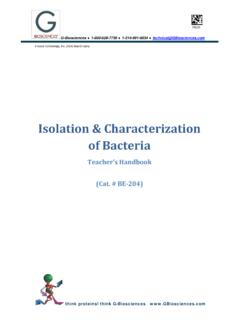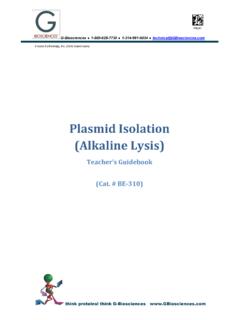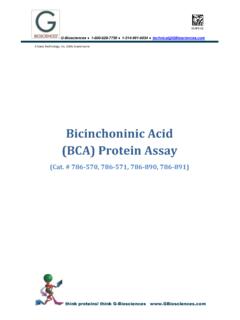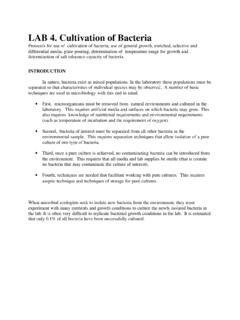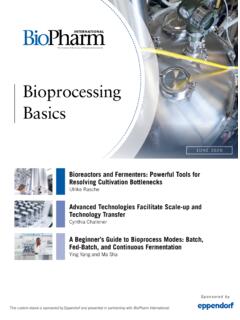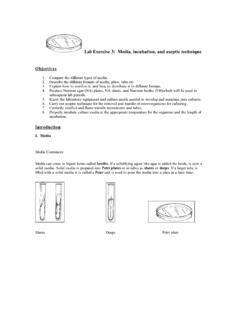Transcription of Bacterial Culture & Growth - G-Biosciences
1 G-Biosciences 1-800-628-7730 1-314-991-6034 A Geno Technology, Inc. (USA) brand name think proteins! think G-Biosciences PR019 Bacterial Culture & Growth Teacher s Guidebook (Cat. # BE 201) Page 2 of 12 MATERIALS INCLUDED .. 3 SPECIAL HANDLING INSTRUCTIONS .. 3 ADDITIONAL EQUIPMENT REQUIRED .. 3 TIME REQUIRED .. 3 OBJECTIVES .. 4 BACKGROUND .. 4 TEACHER S PRE EXPERIMENT SET UP .. 5 MATERIALS FOR EACH GROUP .. 5 PROCEDURE .. 6 I. MEDIA PREPARATION .. 6 II. LIQUID Culture : INOCULATION AND Bacterial Culture .. 6 III. SOLID Culture : INOCULATION AND DILUTION ON SOLID Culture .. 7 RESULTS, ANALYSIS & ASSESSMENT .. 9 MATERIALS INCLUDED This kit has enough materials and reagents for 24 students (six groups of four students).
2 1 vial Bac: K 12 Agar Stab 1 vial LB Broth 2 bottles LB Broth 1 bag 6 LB Broth capsules 1 pack LB Agar 6 Petri Dishes 6 Inoculating Loops 6 vials Loop Wash SPECIAL HANDLING INSTRUCTIONS Store Bac: K 12 Agar Stab at 4 C. All other reagents can be stored at room temperature. The majority of reagents and components supplied in the BioScience Excellence kits are non toxic and are safe to handle, however good laboratory procedures should be used at all times. This includes wearing lab coats, gloves and safety goggles. For further details on reagents please review the Material Safety Data Sheets (MSDS). The following items need to be used with particular caution.
3 Part # Name Hazard L041 Loop Wash Flammable ADDITIONAL EQUIPMENT REQUIRED 250 300ml Erlenmeyer ( Culture ) flasks Autoclave* Shaking Incubator Incubator 10ml Sterile Culture Tubes Spectrophotometer and cuvettes * 100ml premade bottles of LB broth (Cat. # L021 C) and LB agar (L011), which is melted in a boiling waterbath, can be used if an autoclave is not available. You will require 6 x LB Broth and 2 x LB Agar bottles. TIME REQUIRED Day 1: 1 2 hours Day 2: One day (9 x 20 minutes) Day 3: 20 minutes Page 3 of 12 OBJECTIVES Learn aseptic techniques Learn manipulation of bacteria Study Bacterial Growth in liquid Culture Cultivation of bacteria on solid agar, streaking and dilution Isolation a single Bacterial colony BACKGROUND This kit teaches aseptic handling techniques, cultivation of bacteria in liquid broth and on solid Culture media.
4 This kit designed to educate students in the lag, log, stationary and decline phases of the Bacterial Growth cycle and how to monitor the various stages. In addition, the kit teaches the importance of Bacterial liquid Culture in biotechnology and its applications in industrial biotechnology. This laboratory activity involves preparation of Culture medium, inoculation, and monitoring of the liquid Culture through the four Growth stages. The laboratory activity also teaches cultivation of bacteria on agar, streaking, serial dilution and isolating a single Bacterial colony. This laboratory activity uses the most widely used medium for common Bacterial Culture . LB (Luria and Bertani) broth consists of 1% tryptone, yeast extract and sodium chloride.
5 The solid media, LB agar, consists of 1% tryptone, yeast extract, sodium chloride and agar. Both LB broth and LB Agar are rich in nitrogen, carbon and salts to meet the requirement of Bacterial Growth . Both media do not require the adjustment of pH. For convenience both LB media are supplied as premixed preparations, LB Broth as capsules. Fresh medium is prepared by adding water followed by sterilization. In the case of bacteria or other unicellular organisms cell Growth refers to cell division rather than to the size of the individual cell. The rate at which Bacterial cells divide in Culture is influenced by several factors, including the level of available nutrients, the temperature, pH and the degree of agitation.
6 There are four different phases in a typical Bacterial Growth curve, the lag, log or exponential, stationary and the decline or death phase. LAG PHASE: Growth is slow at first, while the bacteria acclimatize to the nutrients and conditions in the Growth media. LOG PHASE: Once acclimatized, the bacteria begin to rapidly divide at an exponential rate, doubling every 10 20 minutes. STATIONARY PHASE: The increasing numbers of bacteria begin to compete for the dwindling nutrients and their exponential Growth is inhibited. The number of bacteria stabilizes. DEATH PHASE: The decreasing amount of nutrients and increasing levels of toxic byproducts results in harmful conditions for the bacteria and they begin to die.
7 Page 4 of 12 TEACHER S PRE EXPERIMENT SET UP 1. Using aseptic techniques transfer the entire content of both bottles of LB Broth to a sterile 250 300ml sterile Erlenmeyer flask. 2. Transfer LB broth to the Bacterial agar stab and incubate at 37 C for 30 minutes. Vigorously shake or vortex. 3. Transfer LB broth from the agarose stab to the Erlenmeyer flask. 4. Culture the bacteria in 37 C shaker overnight. 5. The following day, dispense 6 8ml overnight Culture into six sterile Culture tubes. Each group of students receives a single tube. MATERIALS FOR EACH GROUP Supply each group with the following components. Some of the components are shared by the whole class and should be kept on a communal table.
8 6 8ml K 12, overnight Culture 1 capsule LB Broth, dry capsule 1 pack LB Agar (shared with class) 1 Petri Dish 1 Erlenmeyer ( Culture ) flask (250 300ml) (Shared with class) 1 Erlenmeyer ( Culture ) flask (250 300ml) (per group) 1 Inoculating Loop (shared with group members) 1 vial Loop Wash Marker Pen Page 5 of 12 PROCEDURE I. Media Preparation Wear heat protective gloves throughout the autoclaving and the agar pouring procedure. Agar plates can be made up to a week in advance, stored in an airtight container at 4 C. 1. The media preparation is performed as a class or the media may be prepared in advance by your teacher. 2. LB Broth Preparation: Each group places one capsule of LB Broth in to a 250 300ml flask.
9 Add 50ml distilled water and tightly cover the flask mouth with aluminum foil, similar plug or lose cap. 3. LB Agar Preparation: As a class, transfer the LB Agar to a 250 300ml flask. Add 150ml distilled water and tightly cover the flask mouth with aluminum foil, similar plug or lose cap. 4. Autoclave the LB Broth and LB Agar for 15min at 121 C. Turn the autoclave off. Wait for the autoclave to cool and the pressure to become zero. Instruct students not to open the autoclave until it has cooled and the pressure becomes zero. 5. Remove the media from the autoclave and leave to cool at room temperature. Once the LB Agar has cooled to hand hot temperature (about 45 C), pour a ~ layer of agar into six Petri dishes.
10 This is approximately 20 25ml volume of agar. 6. Leave the Petri dish on a flat surface for 30 40 minutes until completely set. II. Liquid Culture : Inoculation and Bacterial Culture 1. Transfer 1ml LB broth to a tube to be used as a blank later. 2. Inoculate the remaining LB broth with 5ml overnight Culture that will be supplied by your teacher. Gently swirl the flask in a circular motion to thoroughly mix. 3. Transfer 1ml of your Culture to a cuvette. Using a spectrophotometer at 600 700nm, zero (blank) the colorimetric spectrophotometer with the LB broth from step 1. Save the blank LB broth. You may need it in next step. Measure the Page 6 of 12 absorbance of the Culture sample.
